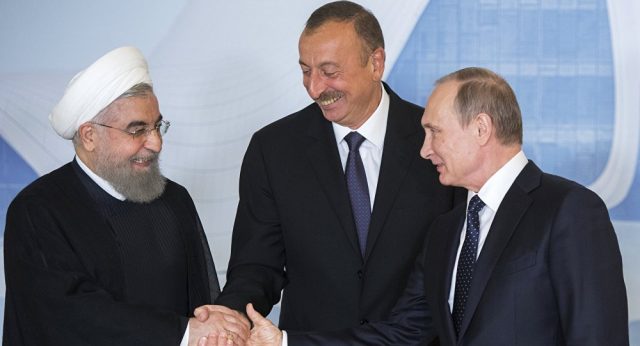
Russia Pushes ‘Gas Swap’ Plans With Iran Amidst Azerbaijan-Iran Gas Talks
Publication: Eurasia Daily Monitor Volume: 13 Issue: 145
By:

The Presidents of Azerbaijan, Russia and Iran—Ilham Aliyev, Vladimir Putin and Hassan Rouhani, respectively—met in Baku, on August 8, and signed a Joint Declaration committing their countries to deepening cooperation on energy. In particular, the three sides pledged to collaborate on exploring oil and natural gas deposits, sharing technology on energy supply and transport, as well as the joint use of pipeline infrastructure for the transit of raw materials (President.az, August 9; Kremlin.ru, August 8).
Russian Energy Minister Alexander Novak said that Russia is considering natural gas supply swaps to northern Iran via Azerbaijan, with the possibility of building a gas liquefaction plant in Iran’s south in order to receive enough liquefied natural gas (LNG) for export to Southeast Asian markets. According to Novak, the proposed swap deals would help to cut Iran’s gas transportation costs to its northern regions from the south (TASS, August 8; Natural Gas Europe, August 11). Russia will be able to benefit from the transit status of Azerbaijan by supplying natural gas to Iran’s north and, in exchange, have LNG transported to the lucrative Asian markets from Iran’s south. The transportation of Russian gas through Azerbaijan to northern Iran could be also realized via the Gazimagomed–Astara–Bind–Biand (GABB) pipeline (Kommersant, October 26, 2015).
Shortly after the trilateral heads of states meeting, Iran’s Deputy Oil Minister for International Affairs Amir-Hossein Zamaniniya announced that Iran will likely store its gas in Azerbaijan’s underground gas storage (UGS) facilities. Azerbaijan has two UGS facilities (Garadagh and Galmaz), with a total capacity of 5 billion cubic meters (bcm) of gas (News.az, August 13). Earlier, the president of the State Oil Company of Azerbaijan Republic (SOCAR), Rovnag Abdullayev, had also announced that SOCAR was negotiating with Iran on a gas swap operation. During his visit to Iran in July 2015, Abdullayev mentioned that Azerbaijan has invested in increasing the capacity of its gas storage from 800 million cubic meters to 3.5 bcm. He added that his country could store Iranian gas in its massive UGS facilities (Report.az, July 20, 2015). Azerbaijan is working on expanding and upgrading its UGS facilities and infrastructure as well as designing new gas wells (Trend, August 26).
Presently, Azerbaijan’s two UGS facilities could store around 2 bcm of Iranian gas, while Iran’s natural gas production demonstrates a surplus in summer. Iran can receive this gas back in winter, when its gas production falls short of domestic consumption (Today.az, August 11). However, according to an unnamed source from SOCAR: “These storages might be used ‘virtually’ because there is no physical means for delivering Iranian gas and pumping it into UGS near Baku. But, Azerbaijan can pump its additional gas into storage and supply it to Iran’s northern region during winter, when they experience gas shortages. Iran will supply the same amount of gas to the southern regions of Azerbaijan […] and Nakhchivan [in the summer time]” (Natural Gas Europe, August 11).
Azerbaijan could also boost its gas supply through the GABB gas pipeline (used to swap natural gas deliveries from Azerbaijan to Iran, in return for the provision of Azerbaijan’s Nakhchivan Autonomous Republic with Iranian gas) to Iran’s northern regions. In return, Iran can export its own gas, as Azerbaijani gas, from the Persian Gulf in the form of LNG (Caspiania.org, July 22, 2015). For that reason, Azerbaijan constructed a compressor station in Astara rayon, at the border with Iran, to boost gas supplies to Nakhchivan and increase exports to Iran (Haqqin.az, July 20, 2015).
In 2015, Iran’s ambassador to Azerbaijan, Mohsen Pak Ayeen, said, “Azerbaijan can invest in Iran’s oil and gas fields in the Persian Gulf and we can enlarge the transportation potential of Azeri gas through swapping and cooperate on export of our oil and gas resources to third countries. Tehran is ready for joint development of the oil and gas fields in the Caspian Sea” (Caspian Barrel, August 5, 2015). The Iranian sector of the Caspian Sea holds massive natural gas reserves. However, these reserves are located in the deepest point of the Caspian, and Iran does not have the advanced technology needed for extraction (Payvand.com, March 5, 2015). Azerbaijan, on the other hand, has the necessary technologies and experience, from which Iran may be able to benefit.
Azerbaijan can also transport Iran’s Caspian gas through its territories from the south to the north, via the GABB pipeline in reverse flow and inject it into the South Caucasus Pipeline (SCP) in Azerbaijan, then onward to Georgia. Azerbaijan’s Deputy Energy Minister Natig Abbasov recently noted, “Azerbaijan is considering the possibility to transport Iranian gas through its territory to Europe through Iran’s participation [in] the Trans-Anatolian Natural Gas Pipeline project [TANAP—currently under construction]” (Trend, August 29). Along with the Trans-Adriatic Pipeline (TAP) to be built across the Balkans, TANAP and the SCP link up to make up the Southern Gas Corridor, which will deliver Caspian-basin gas to European markets.
SOCAR had earlier expressed interest in importing around 3–5 bcm of gas per year from Russia’s Gazprom. Reportedly, Russian gas would help meet domestic gas consumption, while SOCAR’s associated gas will be re-injected into oil reservoirs to maintain steady oil output. Some amount will also be used to test the capacity of Azerbaijan’s UGS facilities (Azernews.az, May 12; Natural Gas Europe, February 12). In September 2015, SOCAR had agreed with Gazprom to import 2 bcm of Russian gas for temporary swaps to preserve them in its UGS reservoirs and later to supply gas back to Russia’s southern regions as of 2017 (Trend, September 17, 2015). Whereas, SOCAR President Abdullayev unexpectedly declared that his company is negotiating with Iran on the purchase of technical gas to fill its UGS facilities, since the company is not satisfied with Gazprom’s gas import terms (Trend, September 5).
Actually, Azerbaijan’s gas storage sites might be used for the Russia-Iran gas swap deal as well. Specifically, Azerbaijan could save Russian gas in its UGS facilities and deliver it to northern Iran either continuously or in winter. However, Russian gas shipments to northern Iran (either through a swap deal or via the Gazimagomed–Astara–Bind–Biand pipeline) might hamper the possible swap deal plans between Azerbaijan and Iran. This, in turn, could decrease the importance of Azerbaijan’s regular gas supplies to the same region, which is carried out in a swap format to supply Iranian gas to Nakhchivan.




